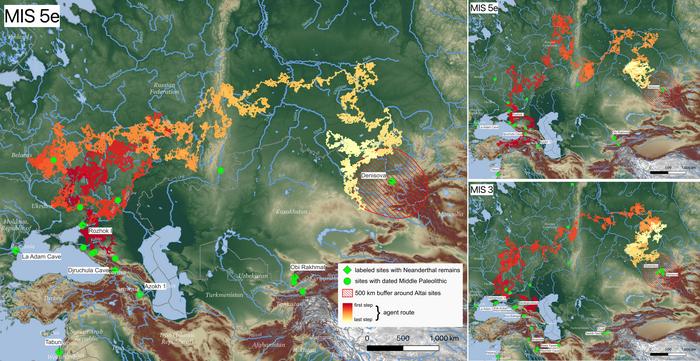Recent advances in anthropological research have unveiled compelling new insights into the migratory patterns of Neanderthals during the Middle to Late Pleistocene era. Utilizing cutting-edge computational simulations, scientists have reconstructed plausible northern migration routes, suggesting that Neanderthals could have traversed vast expanses of Eurasia much more rapidly than previously assumed. This breakthrough is a significant leap in understanding prehistoric human dispersals and the interactions between archaic human species.
For decades, the puzzle of how Neanderthals ventured from Eastern Europe deep into Central and Eastern Eurasia has persisted, primarily due to the deceptively sparse archaeological record connecting these two expansive regions. This gap in the fossil and artifact evidence severely limited researchers’ ability to chart Neanderthal movements with specificity. Now, through agent-based modeling and landscape analysis, researchers have proposed detailed migration pathways revealing that Neanderthals likely exploited river valleys and ecological corridors that acted as natural conduits facilitating rapid movement.
The study, conducted by Emily Coco and Radu Iovita, employed advanced computer simulations to quantify how environmental factors such as topography, fluvial networks, temperature regimes, and glacial barriers collectively influenced Neanderthal dispersal strategies. By integrating reconstructed ancient river courses and paleoclimatic data, their model identifies a sweeping northern corridor running through the Ural Mountains into southern Siberia. Remarkably, these routes align closely with known archaeological localities, reinforcing the model’s ecological and historical plausibility.
These simulations encompass two major warm periods during the Quaternary—the Marine Isotope Stage 5e (approximately 125,000 years ago) and Marine Isotope Stage 3 (around 60,000 years ago). During these interstadial phases, ameliorated climatic conditions would have allowed Neanderthals to migrate over 2,000 miles (roughly 3,250 kilometers) in under two millennia. The model accounts for physiological and behavioral constraints of Neanderthals, assuming optimal foraging and travel behaviors within the environmental matrix of that era.
Beyond mapping physical routes, the research carries broader implications for the understanding of hominin population dynamics, particularly interactions with the Denisovans, an enigmatic archaic group occupying parts of Siberia. The northern migration corridors modeled intersect territories believed to be Denisovan habitats, lending further support to genomic evidence indicating interbreeding events between Neanderthals and Denisovans. This complex web of ancient hominin connectivity emerges more clearly with these computational reconstructions.
Importantly, this study pioneers the application of agent-based computational ecology methods—previously limited to modern species migrations—to Neanderthal populations. Unlike traditional archaeological reconstructions reliant heavily on static artifact records, this dynamic modeling approach elucidates behavioral patterns in response to evolving environmental variables over millennia. The integration of such multidisciplinary techniques enhances predictive capabilities concerning ancient human mobility under variable climate and landscape conditions.
In concert with previous genetic studies suggesting rapid dispersals, the simulations quantitatively confirm that landscape features alone could have directed and constrained Neanderthal movements, making swift, long-distance migrations not only feasible but likely under favorable climatic windows. This challenges earlier notions that Neanderthal populations were highly localized and slow to expand, portraying them instead as adaptable hominins capable of exploiting complex ecological niches.
The rigorous computational framework also incorporates elevation gradients and simulated ice sheet extents to realistically model travel difficulty and potential bottlenecks. These geographic constraints delineate plausible routes with migratory flux patterns showing convergence points near river confluences and resource-rich valleys, consistent with hunter-gatherer settlement ecology. These insights underscore the significance of environmental corridors in prehistoric population dispersal and survival.
Moreover, the findings highlight the temporal specificity of migration events, linking them to discrete climatic episodes conducive to expansion. The warm interstadial intervals allowed for relatively unhindered movement across what would otherwise be formidable glaciated or arid barriers. This temporal framing provides a nuanced understanding of how climate oscillations orchestrated early human migration pulses rather than steady, gradual spread.
The study’s utilization of the NYU Greene Supercomputer Cluster facilitated the computational intensity required for simulating thousands of agent-based scenarios considering stochastic decision-making by virtual hominin groups. This high-performance computing approach marks a transformative advancement in paleoanthropology methodologies, enabling researchers to explore complex hypotheses about human evolution and migration at unprecedented scales.
Ultimately, this research reshapes our portrait of Neanderthal behavioral ecology. These hominins were capable of extensive range expansions utilizing sophisticated landscape knowledge and adaptive strategies in variable environments. The resulting migration pathways not only illuminate the mechanics of Neanderthal dispersal but also establish a blueprint for future interdisciplinary research harnessing computational technologies to decode ancient human histories.
By revealing the feasibility of rapid northern dispersals from Western Eurasia to Siberia, the study invites a reevaluation of how prior climatic and geographic factors shaped hominin evolution and interspecies interactions across Eurasia. It also affirms the critical role computational modeling plays in filling gaps left by fragmentary archaeological evidence, deepening our understanding of humanity’s complex prehistory.
Subject of Research: Neanderthal migration routes and dispersal patterns during interstadial periods in Eurasia, modeled via computational simulations.
Article Title: Agent-based simulations reveal the possibility of multiple rapid northern routes for the second Neanderthal dispersal from Western to Eastern Eurasia
News Publication Date: 9-Jun-2025
Web References: http://dx.doi.org/10.1371/journal.pone.0325693
Image Credits: Emily Coco and Radu Iovita
Keywords: Neanderthals, Anthropology, Human evolution, Early humans, Computational simulation, Migration pathways




